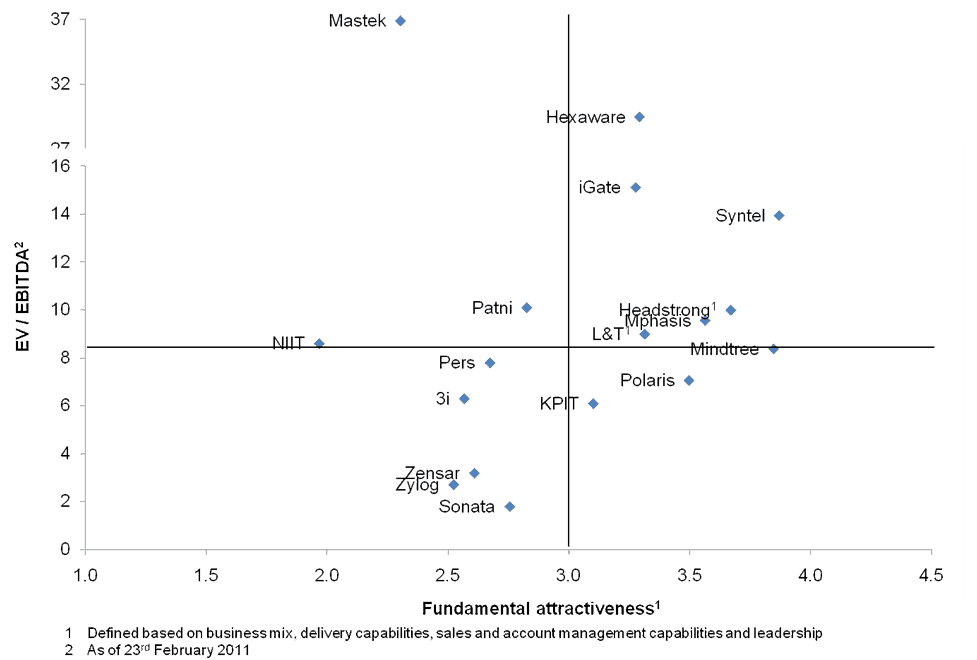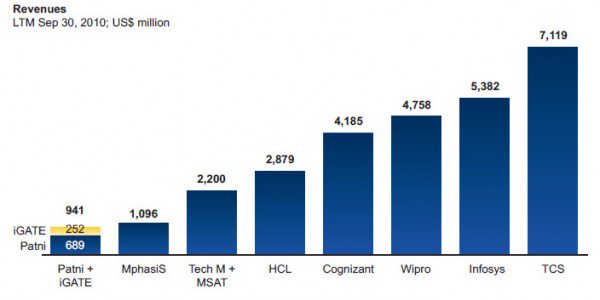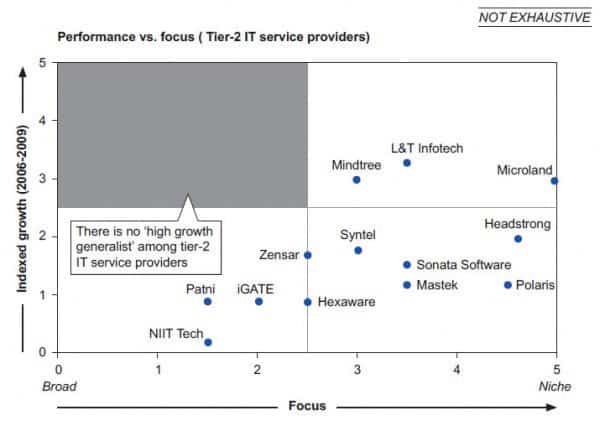Life in the Mid-Tier IT Services Log Jam | Sherpas in Blue Shirts
When Harvard Business School professor Michael Porter said, “Operational excellence may be at the heart of much of today’s business thinking, but it has little to do with what it takes to make a company truly successful,” he could easily have been speaking directly about and to the mid-tier IT service provider community.
Think about it. All 15-20 players in this US$100 million+/sub billion dollar revenue segment have gotten the basics of low costs and high productivity right. Not much differentiation there. In a space as crowded as the malls of Mumbai on a Saturday evening, the key to success lies in finding and strongly demonstrating a truly distinctive market position in terms of business mix, sales and account management capabilities, strategy and leadership. Let’s look at several examples for corroboration.
MindTree, with a three-year CAGR (2007-2010) of ~25 percent and EBITDA margins at 20 percent, has been doing well. Further, more than 50 percent of its revenues come from high margin and high growth non-ADM services such as product engineering. With recent IT infrastructure management service deal wins amounting to over US$70 million, MindTree is in the news for all the right reasons. Its strategic focus on building an engineering and R&D services business, and a leadership team that has largely remained consistent and reputed, have ensured it is one of the front-runners making a differentiating mark in this space.
In the same cluster, it is clear that Syntel is the biggie among the small guys. It is also one of the few companies to have seen steady growth through the turbulent 2008 – 2009 time period. It has had a three-year CAGR of 16 percent and EBITDA margins ranging between 25 and 30 percent. More than 60 percent of its revenue is in the BFSI sector, and ~25 percent comes from non-ADM segments; its successful joint venture with State Street Bank accounts for more than 20 percent of its revenue; and it has a consistent contribution at ~20 percent from American Express…these are only a few of the factors going right for Syntel. With a strategic focus on BFSI and healthcare, both high-growth, high opportunity verticals, it seems to be attacking the market in the right direction.
On the lower end of the spectrum is Headstrong, a privately held company, small even in size as compared to US$0.5 billion+ players like Syntel. A cursory skim through the company’s financials does not reveal anything incredible – growth bordering around 17 percent, and EBITDA margins in the range of 15-17 percent. However, the company does have some distinctive strengths. An active provider of IT services in the sell-side capital markets, it garners more than 70 percent of its revenue from this space. It is also foraying into business consulting, where most of its activity comes from Japan. With a capable leadership, Headstrong is a great example of a niche-focused company driving success.
The last one we’ll look at here is Hexaware, a company whose current financials are not very impressive. BFSI exposure of over 50 percent of revenue battered it during the chaotic times of 2008-2009. Yet that focus is likely to help it rebound as the markets recover driven by BFSI. Further, Hexaware’s considerable presence in enterprise services (~28 percent of revenue) and sizeable European focus (almost 30 percent of revenue) does make it a differentiated play in this market. However, its focus on eight areas may not be a very prudent strategy given its sub-US$300 million revenue base.
Clearly, these companies demonstrate the key ingredients of success through differentiation — a focus on high growth business segments like BFSI, healthcare and product engineering, consistent leadership, account management and mining capabilities, and delivery competence in terms of tools and domain knowledge.
However, given their sizes and the cluttered nature of the IT services sector, the industry is eagerly awaiting a game-changing move. Against the backdrop of the Patni-iGate merger, the market is abuzz with the big question, “What’s next in this space?” Is it a consolidation of complements following closely on the heels of Patni-iGate? Is it an acquisition of one or more of these companies by an Indian Tier-1 player? Revival of the markets, and the presence of maturing private equity investments in several of these firms, continue to fuel to these questions.
The rumor mills are making the rounds with news of assets in play on the deal street. This industry definitely seems to be heading toward some very interesting times.



